History and exam
Key diagnostic factors
common
anogenital ulcer
Initially a macule, developing into a papule and then ulcerating to form a chancre. [Figure caption and citation for the preceding image starts]: A primary vulvar syphilitic chancre due to Treponema pallidum bacteriaCDC: PHIL image ID 5340; used with permission [Citation ends].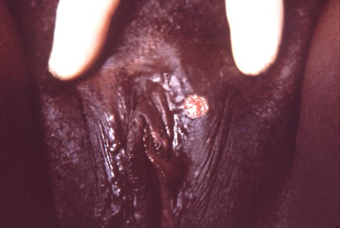
Classically appears in the anogenital area 14 to 21 days after exposure (primary infection).
Usually indurated, solitary, and painless. [Figure caption and citation for the preceding image starts]: A penile chancre located on the proximal penile shaft: primary syphilitic infectionCDC/ Dr Gavin Hart; Dr NJ Fiumara; used with permission [Citation ends].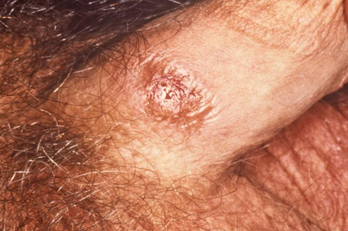
May not always be noticed by the patient and examining physician, and it heals spontaneously.
Atypically may be multiple and painful. Coinfection with genital herpes or chancroid may cause painful ulceration. HIV coinfection may be associated with multiple ulcers.
Erosions on the genitalia may also occur in secondary syphilis. [Figure caption and citation for the preceding image starts]: Secondary syphilitic lesions of vaginaCDC/J. Pledger; used with permission [Citation ends].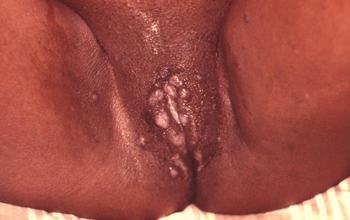
lymphadenopathy
Moderately enlarged, rubbery regional lymphadenopathy associated with the classical syphilitic ulcer (chancre) in primary infection.
Generalized lymphadenopathy may occur with secondary syphilis.
diffuse rash
Symmetric macular, papular, or maculopapular rash in secondary syphilis. [Figure caption and citation for the preceding image starts]: Secondary syphilitic papulosquamous rash on the torso and upper bodyCDC/Susan Lindsley; used with permission [Citation ends].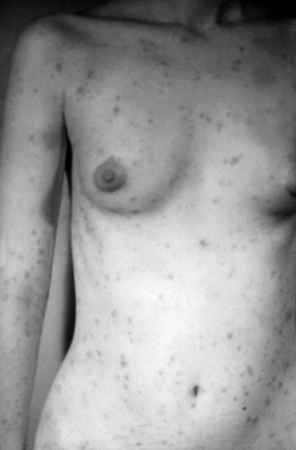
Often widespread with mucous membrane involvement. [Figure caption and citation for the preceding image starts]: Secondary syphilis presenting pigmented macules and papules on the skinCDC/Susan Lindsley; used with permission [Citation ends].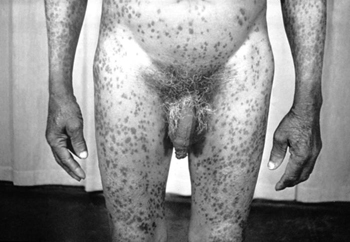
May desquamate.
Usually nonitchy, over the trunk, palms, soles, and scalp.
In dark-skinned patients may cause pruritus.
May accompany a history of constitutional symptoms such as fever and malaise.
Onset is usually 6 to 12 weeks after exposure.
Up to 25% of people who have untreated secondary syphilis develop relapsing episodes of rash and fever.[9][15]
Rash also occurs in congenital syphilis.
constitutional symptoms
fatigue
As a result of cardiovascular syphilis (tertiary disease), which may lead to heart failure.
May also be a constitutional symptom in secondary syphilis.
rhinitis (congenital syphilis)
A sign of early congenital syphilis (occurring <2 years of age).
Discharge may be purulent and bloody.
hepatosplenomegaly (congenital syphilis)
A sign of early congenital syphilis (occurring <2 years of age).
Usually associated with other signs of disseminated infection (rash, mucous membrane ulceration).
uncommon
patchy alopecia
May develop in secondary syphilis.
condylomata lata
Slightly raised, or flat, round, or oval papules covered by gray exudates.
A sign of secondary syphilis.
May be present within moist areas of the perineum.
May be mistaken for genital warts.
memory impairment, altered mood, confusion, or dementia
Possible signs of neurosyphilis.[16]
Brain involvement in tertiary syphilis causes a range of syndromes, including cognitive and motor impairment, which are sometimes grouped under the broad term "general paresis".
visual changes
Visual impairment may be a presenting feature of syphilitic iritis or uveitis, occurring in secondary infection.
Argyll-Robertson pupils
Bilaterally small, irregular pupils, which do not constrict when exposed to bright light, but do constrict in response to accommodation.
A feature of tabes dorsalis occurring in tertiary syphilis.
loss of sense of vibration, proprioception, and position sense
Dorsal column loss is a feature of tabes dorsalis, occurring in tertiary syphilis.
ataxia
A feature of tabes dorsalis occurring in tertiary syphilis.
loss of anal and bladder sphincter control
A feature of tabes dorsalis occurring in tertiary syphilis.
positive Romberg sign
A feature of tabes dorsalis occurring in tertiary syphilis.
diastolic murmur
Possible sign of cardiovascular syphilis (tertiary disease).
Diastolic murmur at the left sternal edge indicates aortic regurgitation, which may be due to aortitis caused by cardiovascular syphilis.
rubbery lesions/nodules with a necrotic center
A sign of gummatous syphilis (also known as benign tertiary syphilis).
Affects skin and visceral organs.
The destructive gumma may gradually replace normal tissue.
miscarriage, stillbirth, or neonatal death (congenital syphilis)
Signs of congenital syphilis.[69]
premature labor and intrauterine growth retardation (congenital syphilis)
Signs of early congenital syphilis.
neonatal skin rash (congenital syphilis)
May occur in early congenital syphilis (occurring <2 years of age).
This rash may be similar to the rash of secondary syphilis in adults. It may also be more widespread, bullous or papulonecrotic, or desquamating.
Initially the rash may be a vesicular rash with small blisters appearing on the palms and plantar surfaces of the feet. An erythematous or maculopapular rash, which is often copper-colored, may subsequently appear on the face, palms, and plantar surfaces of the feet. The rash may also affect the mouth, genitalia, and anus.[Figure caption and citation for the preceding image starts]: This was a case of congenital syphilis resulting in the death of this newborn infantCDC: PHIL image ID 3510; used with permission [Citation ends].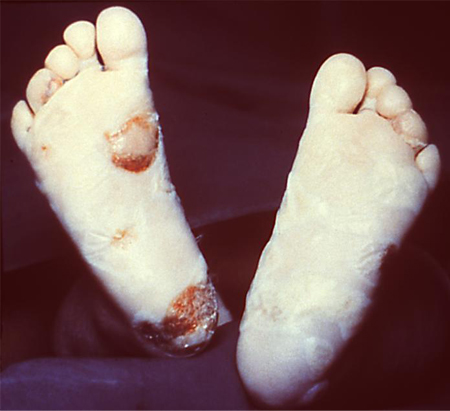 [Figure caption and citation for the preceding image starts]: This newborn presented with symptoms of congenital syphilis that included lesions on the soles of both feetCDC: PHIL image ID 4148; used with permission [Citation ends].
[Figure caption and citation for the preceding image starts]: This newborn presented with symptoms of congenital syphilis that included lesions on the soles of both feetCDC: PHIL image ID 4148; used with permission [Citation ends].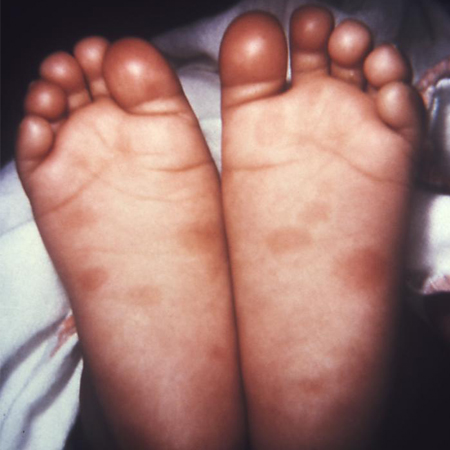
tibial bowing (congenital syphilis)
A sign of late congenital syphilis (occurring >2 years of age).
Due to neonatal osteochondritis in congenital syphilis.[Figure caption and citation for the preceding image starts]: Osteoperiostitis of the tibia ("saber shins")CDC/Robert E. Sumpter; used with permission [Citation ends].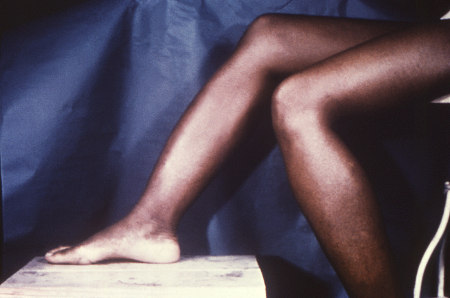
craniofacial malformation (congenital syphilis)
A sign of late congenital syphilis (occurring >2 years of age).
Including frontal bossing, high cranium, and saddle nose.
tooth abnormalities (congenital syphilis)
A sign of late congenital syphilis (occurring >2 years of age).
Hutchinson teeth (peg-shaped incisors, notched at the apex), mulberry molars dome-shaped with small cusps at the apex.
Poorly mineralized teeth.[Figure caption and citation for the preceding image starts]: Peg-shaped, notched central incisors (Hutchinson teeth)CDC/Robert E. Sumpter; used with permission [Citation ends].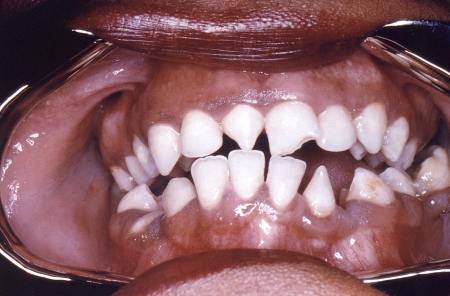
necrotizing funisitis (congenital syphilis)
Necrotizing funisitis (inflammation of the umbilical cord) is virtually diagnostic of congenital syphilis. Usually found in preterm infants who are stillborn, or die within a few weeks of birth.
The umbilical cord has a specific appearance known as the “barberpole” cord as a result of inflammation of the matrix of the umbilical cord.[39]
Other diagnostic factors
common
mouth ulcer
May coexist with genital ulceration.
Occurs in both primary and secondary infection.
In secondary infection the mouth ulcers (snail track ulcers) will usually be coexistent with other symptoms or signs, such as rash, fever.
asymptomatic with positive serology (latent syphilis)
Latent syphilis is defined as positive serology in the absence of clinical features of syphilis.
Ulcers in primary syphilis may not be noticed by the patient and examining physician.
uncommon
tremor
Possible sign of tertiary disease with brain involvement.
Brain involvement in tertiary syphilis causes a range of syndromes, including cognitive and motor impairment, which are sometimes grouped under the broad term "general paresis".
headache
May indicate neurologic involvement.
May occur with neck stiffness.
meningismus
May indicate neurologic involvement.
eye pain
May be a presenting feature of syphilitic iritis or uveitis, occurring in secondary infection.
hearing loss
The eighth cranial nerve is the most commonly affected cranial nerve in neurosyphilis.
Hearing loss may be a symptom and a sign of both early and late neurosyphilis.
Deafness may also occur as a result of late congenital syphilis (occurring >2 years of age).
seizures
Suggest neurologic involvement.
peripheral edema
Occurs with nephrotic syndrome that may develop due to vasculitis in secondary syphilis.
jaundice
May indicate hepatitis, due to vasculitis in secondary syphilis.
peripheral neuropathy
Sign of neurosyphilis.
Usually affecting lower limbs.
areflexia
May occur in all forms of neurosyphilis.
angina
As a result of cardiovascular syphilis (tertiary disease).
dyspnea
As a result of cardiovascular syphilis (tertiary disease), which may lead to heart failure.
Aortic aneurysm caused by syphilis almost always affects the thoracic aorta (usually the ascending part of the thoracic aorta), resulting in heart failure.
organomegaly
Lesions in gummatous syphilis may cause organomegaly, and become infiltrative or destructive.
skin or visceral organ perforation or collapse of structure
May occur as a result of gummatous syphilis.
neonatal neurologic abnormalities (congenital syphilis)
May include a wide range of problems such as seizures, meningitis, obstructive hydrocephalus, and cranial nerve palsies.
Risk factors
strong
sexual contact with an infected person
The risk of acquiring syphilis after sex with someone with primary or secondary syphilis is between 30% and 60%.[15]
men who have sex with men (MSM)
illicit drug use
Association due to the exchange of sex for money or drugs, particularly crack cocaine.[21]
commercial sex workers
Association due to the exchange of sex for money or drugs, particularly crack cocaine.[21]
multiple sexual partners
A risk factor for all STIs.
Important in syphilis epidemiology.[19]
people with HIV or other STIs
Suggests unprotected sexual intercourse, which increases the risk of STIs.
All patients who have an STI should have syphilis screening, as should patients at higher risk of STIs, irrespective of where they are seen.
syphilis during pregnancy (risk for congenital syphilis)
The fetus acquires the infection from the infected mother. Inadequate treatment of maternal syphilis accounts for up to one-third of congenital syphilis cases.[22]
This may result in miscarriage, stillbirth, or neonatal death.[3]
Screening for syphilis at the first prenatal visit aims to identify and treat asymptomatic infected women, thus preventing transplacental transmission.[23] The Centers for Disease Control and Prevention recommends repeating syphilis screening at 28 weeks’ gestation and at delivery for women at high risk of syphilis infection. Risk factors for syphilis infection during pregnancy include commercial sex work, a history of substance misuse, sex with multiple partners, late entry into prenatal care (i.e., first visit during the second trimester or later) or no prenatal care, unstable housing or homelessness, and imprisonment of the woman or her partner.[8]
Use of this content is subject to our disclaimer